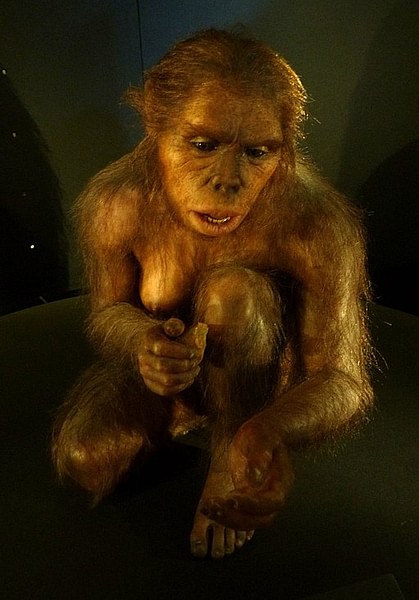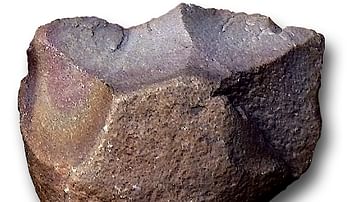
Homo habilis ("handy man") is an extinct species of human that lived in East and South Africa between 2.3 and 1.5 million years ago and plays an interesting role in the discussion surrounding the dawn of our genus of Homo, which is thought to have first appeared around 2.5 million years ago.
Homo habilis was often seen as one of the earliest members of our genus and, for a long time, was commonly depicted as the ancestor of Homo erectus (thus, being a direct ancestor of our own species, too). Nowadays, this is debated, and a much more complex picture of the early days of Homo has emerged. Much discussion remains about the place of Homo habilis within this picture.
The fragmentary fossil record when it comes to Homo habilis (and many other species around at this early time) does not help; though we have a collection of skulls and skull fragments, only three so-called postcranial (below the skull) skeletons have been unearthed, and they are incomplete. The remains showcase a mishmash of features that in some parts resemble Homo, and in others resemble those found in Australopithecus.
What we do know is that Homo habilis was both fully bipedal, as well as a good and probably frequent climber, with strong hands that fashioned stone tools belonging to the Oldowan industry.
Discovery
Homo habilis was first described in 1964 by the British-Kenyan palaeoanthropologist Louis Leakey and his colleagues in a paper that rocked the scientific community. Along with his wife, Mary, Leakey had been combing Olduvai Gorge in Tanzania since the early 1950s in search of traces of Homo's first steps and had already discovered early stone tools belonging to what he termed the Oldowan industry. In the early 1960s, their son Jonathan found several skull and lower jaw fragments, along with some hand bones, in the same fossil bed that had yielded the tools. Soon, more remains were uncovered, including an adult foot, a skull with both upper and lower jaw, and a very fragmented skull with teeth.
Their verdict was that the new remains were quite 'modern' in appearance: they appeared closer to the genus Homo than to that of other early hominins like the Australopithecines. Clearly, this was a good fit for their toolmaker, they argued. Following the definition of Homo that was generally accepted at that time, the team felt the new fossils successfully met three of the key criteria: this species had an upright posture, could walk in a bipedal manner, and had the necessary dexterity to create stone tools. However, the fact that its brain volume was smaller than that of established members of Homo at the time required some fidgeting: the team thus proposed relaxing this criterion a bit.
Leakey's 1964 paper argued for the new species to be added to the genus Homo in the shape of Homo habilis – from the Latin for "handy, skilful, able". The announcement marked a turning point in palaeoanthropology, as Bernard Wood describes: "It shifted the search for the first humans from Asia to Africa and began a controversy that endures to this day." (2014).
Although the Homo habilis taxon was officially validated by the scientific community, it has frequently been challenged and criticised – a battle that is ongoing.
Bones & Brain Size
Homo habilis bones are dated to between c. 2.3 million and 1.5 million years ago. In fact, because the genus Homo is thought to have first emerged around 2.5 million years ago, Homo habilis is right on that interesting cusp where it plays directly into questions about what it means to be human. One complicating factor in understanding Homo habilis, however, is that the evidence is scarce: not all parts of its skeleton have been uncovered. Its femur, for instance, is a complete mystery.
Beginning from the top, the braincase of Homo habilis, coming in at an average cranial capacity of 640 cm³, is noticeably bigger than that of its Australopithecus cousins (or perhaps, sisters, depending on which side of the classification debate you adhere to – see below). Homo habilis' brain is smaller, though, than that of Homo erectus, the globe-trotting, fully-upright success story which partially overlapped with Homo habilis but who survived it by a rather generous mile. Homo habilis' forehead is more vertical than that of Australopithecines and sports weak brow ridges. Its jaw and teeth were more slender, or gracile, than those of its contemporary, Homo rudolfensis, smaller than those of most Australopithecines, but actually had similar proportions to those of Australopithecus africanus.
In the past, brain volume was used as a sort of marker for intelligence and was an integral part of the definition of the genus Homo. The fact that Homo habilis falls short of that mark became a frequent criticism about its inclusion in Homo. However, today, it is broadly accepted that brain size is only part of the story; the organisation of the brain, as well as group dynamics and tool use, all play a huge role in establishing what a species is capable of. The discovery in 2003 of the small-bodied (and, thus, small-brained) Homo floresiensis, nicknamed 'hobbit man', and that of the also smaller-brained Homo naledi in 2013 neatly illustrate this point.
Sadly, we do not have a lot of material with which to properly flesh out Homo habilis' body shape or its hands and feet. What we do have shows a bit of a mishmash of features, with some bits and bobs reminding of Australopithecus while a fair amount looks more like that found in Homo species. Its hands show that habilis would likely have been a pretty good and arguably frequent climber (unlike, for instance, Homo erectus), but its skeleton shows it would also have been fully capable of walking upright, probably more efficiently so than either Australopithecus afarensis or Australopithecus africanus but not quite to the level attained by Homo erectus. Clearly, Homo habilis is far from a clear-cut story, and that is reflected in the scientific community.
Classification Debate
The debate essentially centres on which way to lean with regard to Homo habilis' features. The second player and complicating factor here is Homo rudolfensis, another similarly early species (c. 2.5-1.8 million years ago) which had larger, more robust teeth than Homo habilis but could also walk upright. Some scientists argue that all early Homo specimens should be combined into one unique species and that features that would otherwise separate them into habilis and rudolfensis are simply part of variability within that species. Others (at this point in time, the majority of researchers) uphold the split between habilis and rudolfensis, with some going back and forth about which specimens to include in which species. Some even think both habilis and rudolfensis should be added to Homo erectus.
Whichever camp you favour, here, the question remains where these species can best find their homes on the evolutionary tree. Homo is an option that many scientists still seem to back. Scientists who do not agree with that have suggested adding habilis and rudolfensis to Australopithecus, but that comes with its own issue of making Australopithecus even broader and less clearly defined, too. In the words of palaeoanthropologist John Hawks: "What a mess early Homo is!" (2014).
Palaeoanthropologist Ian Tattersall writes in his 2019 paper that we will only be able to make sense of the situation once we agree that early hominin diversity is a lot greater than can be contained within Homo or Australopithecus. In this vein, it also goes almost without saying that it is difficult to tell which species Homo habilis may have evolved from and which species – if any – it evolved into. Although the most 'obvious' candidate would be Homo erectus, there are plenty of palaeoanthropologists who do not think that tracks. Wood, for instance, explains that in his view: "…the species is too unlike H. erectus to be its immediate ancestor, so a simple, linear model explaining this stage of human evolution is looking less and less likely" (Wood 2014).
Homo Habilis the Toolmaker
A journey into more tangible territory, where we can focus on what we do know about Homo habilis, takes us to their tools. Since the Leakeys' discovery in the 1960s, more evidence has been found that does indeed tie Homo habilis to the Oldowan tool industry (c. 2.6 to 1 million years ago). Oldowan tools overlap not just with Homo habilis but also with Homo rudolfensis and Homo erectus, as well as with later Australopithecines, and it is possible that all of these may have used stone tools to some varying extent. However, most scientists agree that Homo, including habilis, probably made and used tools more habitually, because its teeth got smaller and brains almost doubled in size over the first million years of the Oldowan – cutting up your food means you do not need as chunky of a set of teeth.
The stone tools found in the Oldowan industry were made by striking flakes off a stone core with another stone (hard hammer percussion) or by putting the core to be flaked on a stone anvil and then hitting it with a stone hammer (bipolar technique). Materials such as volcanic lava, quartz, and quartzite were commonly used. Flakes could have been used for such things as butchering animals, woodworking, and cutting soft plant matter, whereas stone hammers could crack bones to access the marrow inside, or crack skulls to get to the brain. Choppers could conceivably have been used as digging sticks or to cut branches. It must be noted, however, that it is hard to assign a direct use or meaning to tools. Cut marks on animal bones tell us the story of carcasses being processed, though, and show us the toolmakers put their tools to bones ranging in size from small mammals to very large ones (up to elephant size). Whether they scavenged or hunted those animals is not known. Either way, the above-mentioned activities could all have featured in Homo habilis' life.
Notably, the Oldowan had long been thought to be the oldest tool industry – the one that started it all – but that is no longer the case. In 2010, fieldwork at Dikika, Ethiopia, revealed cut marks on bones that were clearly inflicted by stone tools a staggering 3.39 million years ago, and in 2015, the site of Lomekwi in West Turkana, Kenya, yielded stone artefacts dated to 3.3 million years ago. This was all clearly before the emergence of the genus Homo, so it is now, more than ever, excessively clear that toolmaking has never been solely a human endeavour.
Environment
We know Homo habilis did not just limit itself to Olduvai Gorge in Tanzania where Leakey found the first specimen; its remains have been found not just at other East African sites such as Koobi Fora in Kenya, as well as in Ethiopia, but also in South Africa at Sterkfontein and, potentially, Swartkrans (which yielded remains of early Homo which are proving difficult to classify). Starting around 2.5 million years ago, the climate in southern Africa cooled and became subject to more seasonal extremes, which likely caused many species (including, perhaps, early Homo habilis or its ancestor) to migrate northward towards the East African Rift Valley. More specifically, we know that around 1.8 million years ago, Olduvai Gorge resembled the present-day Serengeti, so in that location, Homo habilis would have lived in a savannah grassland covered with scrub and bush and some woody plant cover.
How exactly Homo habilis might have interacted with its environment is difficult to answer without entering into speculation. For example, since we have no evidence of any type of living structures at Oldowan sites, one possible but speculative explanation could be that the occupants, who, in Homo habilis' case, are known to probably have been quite good climbers, could have been sleeping in trees (which would have helped them avoid waking up to nightly predators nibbling on their ankles after finding easy prey on the ground).

Predatory animals would certainly have been abundant: the left foot of a Homo habilis individual found at Olduvai seems to have fallen prey to an unfortunate amputation by means of a crocodile mouth, while a leg bone found in the same area (which belongs to either Homo habilis or Paranthropus boisei) was chewed on by a leopard. Other dangers sharing their habitats were, for instance, sabre-toothed cats such as Dinofelis and Meganthereon, and the hunting hyena Chasmaporthetes. Furthermore, Homo habilis shared its world with other species such as Australopithecus africanus, Homo rudolfensis, Paranthropus boisei, and Homo erectus. Whether any possible encounters may have been friendly or the opposite, or something in-between, is anyone's guess.
Diet & Culture
Of course, the environment would have directly impacted Homo habilis' diets, too. Three specimens from Olduvai revealed that their diets likely included insects and/or grass-eating animals – a trend that is also found in early hominins in South Africa. Another Olduvai Homo habilis specimen had a kind of erosion on its molars that might be blamed on chewing immature fruits. From cut-marked bones, we know that meat was obviously on their menu, too. Their teeth furthermore indicate that, because of low-complexity microwear on the molars, Homo habilis likely ate tough and fibrous foods. In general, scientists think their diets would have been quite versatile and flexible.
Interestingly, there are clues indicating that creators of the Oldowan industry – so, perhaps, Homo habilis – were creating concentrations of stone material and animal bones at certain, specific locations. What kind of behaviour caused these concentrations is hard to unravel, though. Speculation includes that they could have been home bases or central foraging places, stone caches, accumulations of scavenged carnivores, or perhaps places that were favoured because of their access to shade, water, or good food resources. In general, using stone tools would have helped Homo habilis be more independent of its environment and would, in turn, have led it to rely more on culture.
Whether Homo habilis used fire in a deliberate way is a topic that remains cloaked in shadow: although some reddened sediments, burnt bones, and fire-cracked stones have been found at a few Oldowan sites, indicating fire, these may simply have been the result of lightning strikes or bushfires. We might also wonder how they communicated and whether they had some form of (proto-)language. There are no direct signs pointing to this, yet, but who knows what the future might hold.
Conclusion
All in all, it is clear that Homo habilis provides us with an interesting mix of what we do know versus what we have so little clue about that it fuels endless discussions. Homo habilis both walked upright and climbed efficiently, made and used stone tools, and survived in varying environments across East- and South Africa, where it not only employed fairly flexible food strategies but also had to be on the lookout for danger in the shape of predatory animals. It shared its world with several other hominin species who all existed in that shadowy zone in time which has not yet yielded enough material to settle any ongoing debates.
Whether Homo habilis was our direct ancestor or an offshoot is a question that may one day be answered. One could argue the main takeaway here is to recognise just how much diversity existed in early hominins. Over the last two or so decades, several new species have been discovered that complicate the story of hominin evolution, and ancient DNA has revealed that interbreeding seems to have been a staple activity, at the very least for the more recent species such as Neanderthals and Denisovans of which scientists have managed to retrieve DNA. The idea that hominin evolution can be visualised as a sort of tree is thus increasingly let go in favour of a more fluid model: like a braided stream (except with added cul-de-sacs for populations that went extinct), species seem to have weaved in and out of contact with one another and have been interconnected in terms of their development. The distant world in which Homo habilis lived and shared its space with others like it may very well fit that model, too.











